The U.S. stock market, as measured by the S&P 500 Index
SPX,
has been volatile on an intraday basis, but net gains and losses have been small. Several minor support and resistance levels have been negated, as the S&P 500 has traded through them in both directions.
Yet major support and resistance levels are still in place, and that defines a trading range that has held SPX in check for the past two months. On the upside, the resistance is at 4100 (the November-December highs), while there is support in the 3760-3800 area (the late December lows).
Meanwhile, SPX is toying with the downtrend line that defines this bear market as well as with its declining 200-day moving average. On one day this week, the entire range of SPX was above its 200-day moving average, for the first time since last March. But there are still sellers in this general area, so in my opinion, the resistance at 4100 needs to be overcome before one can say that the SPX chart has turned bullish.
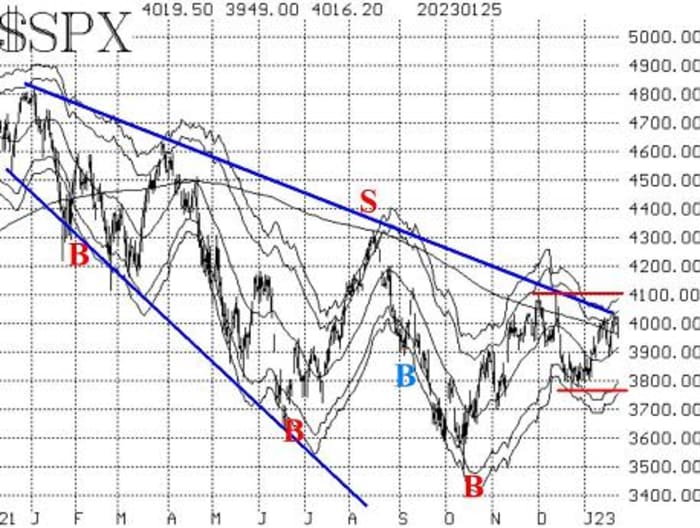
Equity-only put-call ratios have strengthened their buy signals, in that they are making new relative lows. These buy signals were generated at extremely high (oversold) levels on the put-call ratio charts, and in the past that has meant these will be strong buy signals. The total put-call ratio has also given a buy signal.
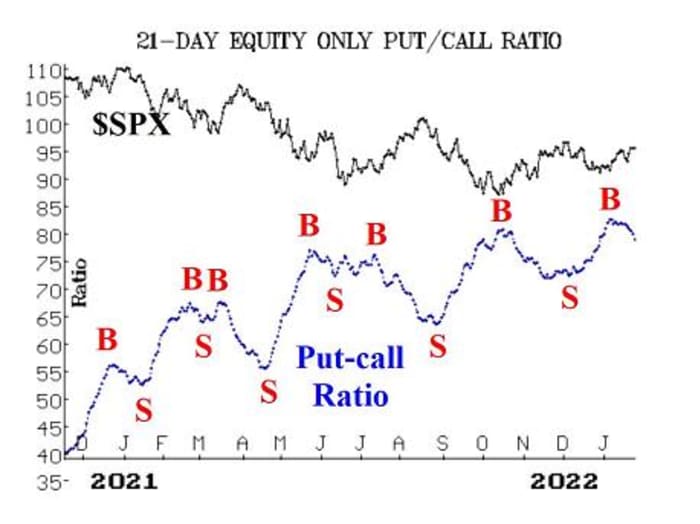
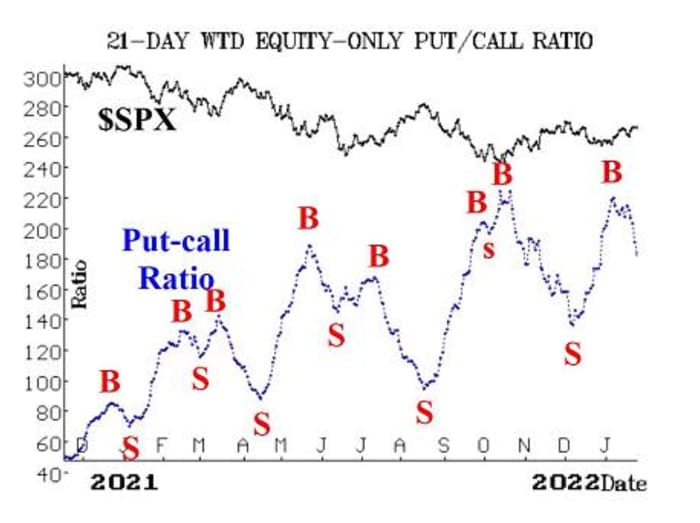
Market breadth (advances minus declines) remains an extremely bullish internal indicator. Both breadth oscillators are on buy signals and are in overbought territory. It is bullish when the oscillators are overbought while SPX is beginning a new leg upward. On January 25, SPX traded down 60 points in the morning, and then spent the afternoon climbing 60 points. Usually, in a situation like that, breadth will finish negative because of the negative start to the day. But, this time, breadth turned positive — another bullish indication.
On the NYSE, new highs continue to outpace new lows, so this indicator — which gave a buy signal last week — remains on that buy signal. It would be reversed if new lows topped new highs on the NYSE for two consecutive days.
The CBOE Volatility Index
VIX,
is at low levels, near 19. In the past year, it has been a warning sign when VIX got this low, for the market soon began to decline after that. I really don’t know if VIX will go much lower even if SPX rises, for the “big money” that trades SPX options (which dictate the price of VIX) is still apparently concerned about the market and is still buying SPX puts.
Outside of that, the trend of the VIX buy signal remains in place. That will only be stopped out if VIX closes above its 200-day moving average — something that is quite unlikely in the near term, since that 200-day MA is at 25.50 and moving sideways.
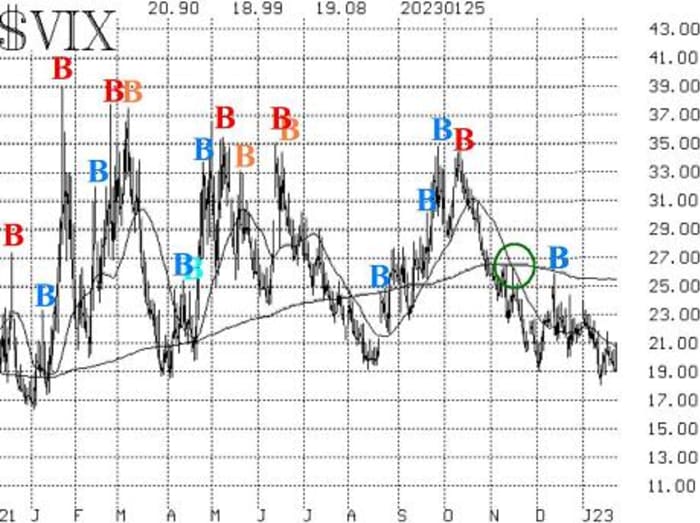
The negative seasonal pattern that typically runs from the 8th to the 18th trading day of January ends tomorrow, Friday, Jan. 27. At that point, a bullish seasonal factor kicks in, and that might be just enough to push SPX above 4100. Still, we are still maintaining an out-of-the-money “core” bearish position, while trading other indicators signals around that.
New recommendation: The January seasonal buy signal
One of the stronger bullish seasonal patterns occurs at the end of January. Typically, funds receive cash inflows right at the beginning of the year, and they invest at least half of those funds right away. That gives rise to the “First 5 days of January” indicator, which was positive this year.
Then, near the end of the month of January, these same funds tend to invest any remaining cash, for they do not like to show excess cash on their month-end balance sheets. That gives rise to a seasonally bullish period that begins on the 18th trading day of January and extends for four or five trading days.
In the past 37 years, SPX has risen 29 times during this period, and the overall average performance of SPX during the four-day period over all 37 years has been a gain of 1.06% in four trading days.
At the close of trading on Friday, Jan. 27:
Buy 2 SPY Feb (10th) at-the-money calls
And Sell 2 SPY Feb (10th) calls with a striking price 15 points higher.
If SPY trades at the higher strike, roll the entire spread up by 15 points on each strike. Otherwise, exit the entire spread at the close of trading four days later – on Thursday, Feb. 2.
New recommendation: National Instruments Corp. (NATI)
Option volume in shares of National Instruments Corp.
NATI,
has remained at an elevated level for several days now. Rumors of another potential bidder — Fortive
FTV,
— have circulated. The company already has one offer from Emerson Electric
EMR,
for $53 per share in cash. A second interested party introduces the possibility of a bidding war and a higher takeover price. Stock volume patterns are extremely strong. There is support at $52. The strikes are five points apart, which makes things a bit more difficult.
Buy 4 NATI Feb (17th) 55 calls at a price of 0.80 or less.
NATI: 54.35 Feb (17th) 55 calls: 0.70 bid, offered at 0.80
If these calls are bought, we will hold without a stop initially, to see if a bidding war develops.
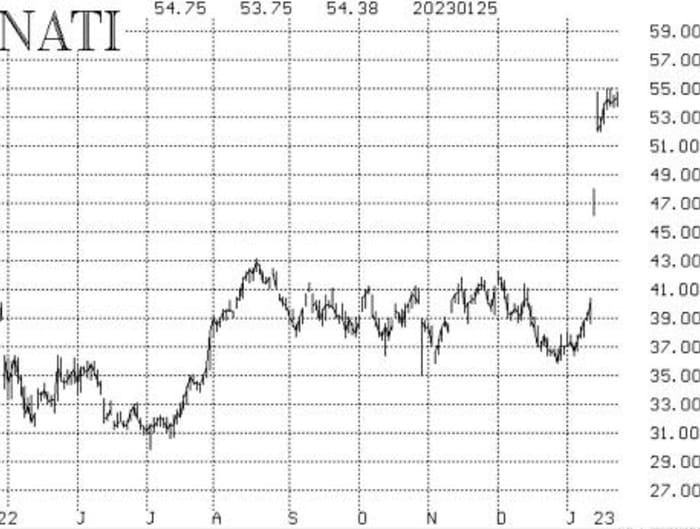
Repeat recommendation: Crude oil buy signal
We are repeating this recommendation from last week, since U.S. Oil Fund
USO,
did not close above our conditional entry price of $72. A put-call ratio buy signal has been generated by crude oil (futures) options. We will trade this with the U.S. Oil Fund options. This, however, is a conditional recommendation in that we want to see follow-through on the upside by USO before we actually enter the position.
IF USO closes above 72,
THEN Buy 2 USO March (17th) 72 calls.
If these calls are bought, we will hold as long as the weighted put-call ratio of Crude Oil futures options remains on a buy signal.
All stops are mental closing stops unless otherwise noted.
We are using a “standard” rolling procedure for our SPY spreads: in any vertical bull or bear spread, if the underlying hits the short strike, then roll the entire spread. That would be roll up in the case of a call bull spread, or roll down in the case of a bear put spread. Stay in the same expiration, and keep the distance between the strikes the same unless otherwise instructed.
Long 2 SPY Feb (17th) 375 puts and Short 2 SPY Feb (17th) 355 puts: this is our “core” bearish position. |As long as SPX remains in a downtrend, we want to maintain a position here. Stop yourself out on a close above 4100 by SPX.
Long 2 PCAR
PCAR,
Feb (17th) 97.20 puts: The put-call ratio has rolled over after a strong earnings report from PCAR. The options are essentially worthless, so we will hold them to see if the stock can pull back some.
Long 1 CVX
CVX,
Feb (17th) 180 call: Hold this position as long as the put-call ratio of CVX remains on a buy signal.
Long 1 QQQ
QQQ,
Feb (3rd) 279 put, Long 1 QQQ Feb (3rd) 282 put, and Long 1 QQQ Feb (3rd) 275 put: We bought these in line with the “January Defect” seasonal trade. Sell all the puts at the close of trading on the 18th trading day of January – Friday, Jan. 27.
Long 2 OSH
OSH,
Feb (17th) 30 calls: Continue to hold without a stop as long as the takeover rumors are in place.
Long 1 SPY
SPY,
Feb (24th) 397 call and Short 1 SPY Feb (24th) 412 call: This spread was bought when the breakout over 3940 by SPX was confirmed, at the close on January 12th. Stop yourself out if SPX closes below 3890.
Long 1 SPY Feb (17th) 389 call and Short 1 SPY Feb (17th) 404 call: This spread was bought in line with the “New Highs vs. New Lows” buy signals. Stop yourself out of this position if New Lows on the NYSE exceed New Highs for two consecutive days.
Send questions to: [email protected].
Lawrence G. McMillan is president of McMillan Analysis, a registered investment and commodity trading advisor. McMillan may hold positions in securities recommended in this report, both personally and in client accounts. He is an experienced trader and money manager and is the author of the best-selling book, Options as a Strategic Investment. www.optionstrategist.com
Disclaimer: ©McMillan Analysis Corporation is registered with the SEC as an investment advisor and with the CFTC as a commodity trading advisor. The information in this newsletter has been carefully compiled from sources believed to be reliable, but accuracy and completeness are not guaranteed. The officers or directors of McMillan Analysis Corporation, or accounts managed by such persons may have positions in the securities recommended in the advisory.
